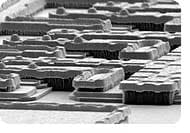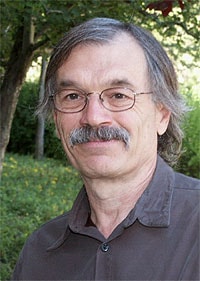The Quiet Fellow
|
|
January 30, 2004
Agilent Labs' researcher and IEEE Fellow Nick Moll makes his mark with a career focused on discovery and 'expecting the unexpected' in the world of compound semiconductor electronics, including HBTs, the highest performing transisters in the world Despite prestigious fellowships with the Institute of Electrical and Electronic Engineers (IEEE) and at Agilent Technologies, numerous patents and a long list of published contributions, Agilent Labs' Researcher Nick Moll avoids the limelight. His quiet, thoughtful demeanor masks the extraordinary scientific creativity that has helped enable some of today's leading high-tech innovations. And even though many of his Agilent colleagues refer to him with terms like "scientific visionary" and "device guru," Moll diffidently shrugs off the attention and emphasizes that his individual contributions pale next to the efforts of the Agilent teams he has worked with during his 30-plus years with the company. This is no false modesty. It is simply how Nick Moll sees the world. Moll has provided leadership in the areas of optoelectronics and compound semiconductor device technology. He has played an integral role in the evolution of small- and medium-scale integrated circuit applications -- particularly Field Effect Transistors (FETs) and Heterojunction Bipolar Transistors (HBTs) -- the highest performing transistors on the planet. This has put him at the forefront of next-generation semiconductor development, working on complex material structures involving compound semiconductors. Moll's work, combined with industry advances in device-structure technology and spurred onward by a slew of talented and committed teams at Agilent, has developed a host of advanced applications. In addition to making a big impact on very-high-performance test and measurement instruments, Moll helped create devices that are used today to provide critical circuitry needed to handle the high data rates of fiber-optic communication networks and in cell phones to boost radio frequencies without burning up precious battery life. Expecting the unexpected
While Moll and his Agilent colleagues focus on technologies that may be invisible to the eye, their contributions in the area of compound semiconductor devices have very visible results. The transistor technologies developed under Moll's leadership have been incorporated into dozens of Agilent instrumentation products. In many cases, his work has provided the differentiating performance feature critical for the success of these products in the marketplace. According to Jim Hollenhorst, director of Agilent Laboratories' Molecular Technologies Laboratory, "Nick's contributions to compound semiconductor electronics have had a tremendous impact on Agilent's revenues over the years." In describing Moll, those who know him best say that he personifies one of those rare solid-state physics sages capable of applying deep knowledge of the science to every real-world solid-state problem. Since leaving Stanford University with his bachelor's and master's degrees in electrical engineering as well as his Ph.D., he has been well grounded in his knowledge, expertise and wisdom of semiconductor devices, and is known for sharing that knowledge and wisdom with others. Moll is widely recognized and respected in the international compound semiconductor community. He has published more than 30 papers, contributed chapters to several books and served as editor of the IEEE Transactions on Electron Devices from 1990 to 1996. Moll became an IEEE Fellow in 1997 and an Agilent Fellow in 2002. Becoming an Agilent Fellow is the highest level of achievement for scientific contributions at Agilent. It recognizes Moll for his technical achievements at Agilent Labs as well as having a major impact across the entire company in his specialized field of expertise. As an Agilent Fellow, Moll continues to provide the same strategic direction that helped bring him the honor, but with more direct access to senior management. Turning technology into products
E-pHEMTs are the heart of Agilent’s cell phone power-amplifier modules. Amplifier components use the most power in a cell phone, so an efficient amplifier can extend battery life by as much as 15 percent. Introduced last year, Agilent’s E-pHEMT power-amplifier modules are now shipping to top-tier cell-phone manufacturers at a rate approaching 2 million units per month. Agilent also produces miniature E-pHEMT FETs that combine exceptional RF performance, power efficiency and reliability in a low-cost package. Moll's other primary area of contribution, HBT technology, has been in production for more than 10 years and is embedded in a diverse set of Agilent high-speed instruments, such as Agilent's spectrum analyzers, network analyzers and signal generators, as well as individual amplifiers. While the device was very successful, Moll continued to push the development envelope by furthering his research in the area of HBTs. In 1998, he was one of the first to recognize the potential of university work combining exotic materials to derive substantially more performance from HBT devices. Working with Professor Colombo Bolognesi at Simon Fraser University in Canada, who was already investigating a transistor with a carbon-doped Gallium Arsenide Antimonide (GaAsSb) base and an Indium Phosphide (InP) collector, Moll used his deep understanding of device physics to greatly advance the work. At the time, combining these materials to enhance performance was considered a nearly impossible feat. By all accounts, it was Moll's dogged persistence and nurturing of the project that helped bring this new technology to market. Currently, Agilent's Worldwide Process and Technology Center in Santa Rosa, California is planning to bring the next-generation HBT process into production this summer. "With this production, I think it is fair to say that Agilent is the industrial leader in this new technology, which involves Indium Phosphide HBTs with the new Gallium Arsenide Antimonide material as a base layer," says Moll. "It provides roughly three times the performance over current HBT technology." Lighting the way
It's that strange attraction to detailed physics that has colleagues, both within and outside of Agilent, frequently seeking Moll out for input. One example is his contributions to LED (light-emitting diodes) technology, which is a rapidly growing area due to its dramatic improvements over other lighting options, such as incandescent lamps. Solid-state LEDs are much more efficient in terms of electricity use and life expectancy, making them popular in a range of applications, including traffic signal lights. Moll, with the help of a small team of Labs employees, helped advance bright LEDs by re-engineering the structure of the diodes to make them even more efficient. The technology lives on at Lumileds Lighting, a joint venture between Agilent Technologies and Philips Lighting founded in 1999. Moll is currently leading a team that is investigating new and emerging devices with the potential to be of future interest to Agilent. "This seemed like a good time to be looking for new technologies," explains Moll. "There are dry periods for technology, and then there are other times when there is a lot going on. This seems to be an especially rich time, because there is so much new technology that has the potential to make really interesting things happen." In pondering what the future of device physics may hold, Moll has no doubt that communication devices will become faster, less expensive and require less power. However, when working in device physics, scientists are ready to venture down new paths they hadn't initially plotted. "We are initiating a new project that could lead us in a variety of areas," says Moll. "I wouldn't be surprised if what we learn takes us in a new direction. We may be looking at a communication device and discover a breakthrough technology in the life sciences. Often, device physics serves as the vehicle that helps us develop an understanding of the details that will eventually lead us to new and beneficial ways to apply the technology." For Moll, science and experimentation is not about being right -- it's about uncovering the truth. The world of device physics can transport scientists in wonderfully new and unexpected directions, which can in turn, open up opportunities for amazing discoveries. And with researchers like Nick Moll leading Agilent's efforts in this area, the company will be well positioned to set the bar for whatever technological advances may lie ahead.
|



